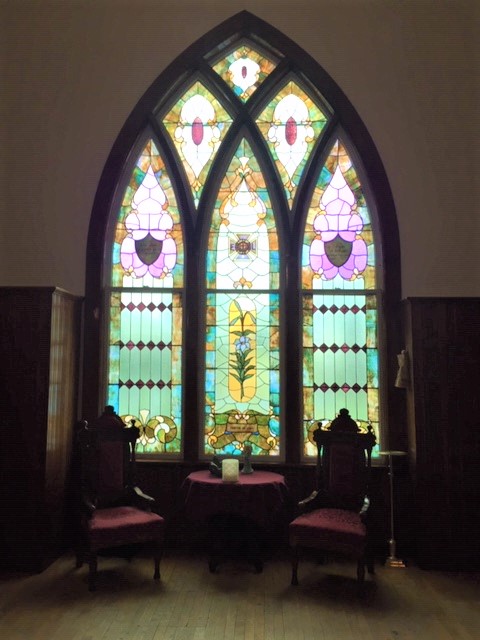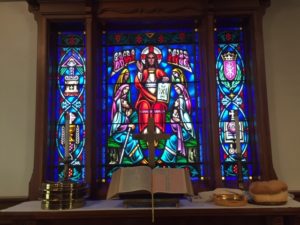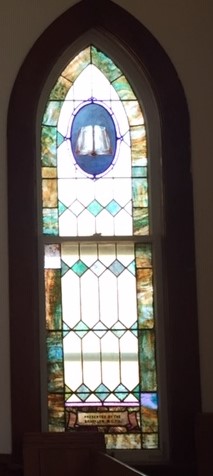Within Our Walls– Our church has welcomed the community for years, even before our present church was built in 1902. Our first church was here for worship and entertainment, allowing everyone to be together. Following the removal of our first church and parsonage, our present church arose. Reverend W.P. McClaskey
was the minister during this transformation.
One of the fundraisers for the new church was on the church lawn on a Friday night. Earlier the Junior League served cake and ice cream followed by recitations by present members and music with Ray Tuttle and Merle Piller. More social gatherings were at the Opera Hall. A supper and fair, scheduled in December 1901 at Tuttle’s Hall asking 15 cents for supper, the ice cream was 10 cents. Largely attended, about $15,000 was pledged that night.
Funerals, marriages, and achieving new members continued to occur the old church.
Building contractor, M.W. Lamont & Sons from Oregon estimated the cost of $3,693 for the new church. They asked the building committee to be responsible for the excavating and stone hauling. T he trustees were asking for “hard heads”-big hard stones. Making ready, the old church was sold and moved, the parsonage had risen,
a waiting to be moved to the site of the old church. Working earnestly, some of the material for the new church was already on the ground on May 31, 1902.
The Ladies Aid sought out different patterns and construction of pews. A contract for pews was decided from the Manitowoc Seating Company for $450. Published in Brooklyn’s newspaper, a description was given of the new church; the auditorium (sanctuary) will be 30 x 50 feet with opening 8 x 24 feet, on the northside was the choir and pulpit with a partition for a study, 8 x 8 the entrance and bell tower measures 12×24 on the southside, and enclosed with white brick. All of the windows have stained windows. The capstone arrived from Peter McMahon, the dealer for McMahon Bros. of Rockford. The capstone was purchased from Bedford Stone (7 ft. in
length and 14 ft. high and 6 in. its raised letters read M.E. Church. Our church bell was purchased in 1889 awaiting to be hung.
After the walls were plastered and the furnace positioned, the Ladies of the Church had their famous Chicken Suppers which drew $42. The dedication was scheduled December 14. All of the windows were up except for the one on the westside. Arriving on the train, they were positioned next to the depot. The wind blew one of the windows down, breaking it badly. It was returned.
Born in Bordertown, N.J., Walter Phillip McClaskey turned to religion at age 23 at a revival in 1885. Coming from Prairie du Sac, he was here from 1901-03. In February 1903, McClaskey preached about Abraham Lincoln and George Washington. The Epworth League extended an invitation to their Washington Birthday Supper, saying “Come and meet George and Martha and get a piece of Washington Pie.” Their $18 profit went towards the
church’s debt. At the supper, McClaskey promised to write during his family’s train journey to Fort Jones near Sacramento, California. Previously, McClaskey had asked for a transfer as his wife and children (twins) found it almost impossible to endure the rigors of our cold winters. A house auction was held and his horse carriage
was sold to the Northwestern Hotel owner, near the tracks. A.L. Wood was assigned to our church.
From Sharon’s history books

Within Our Walls– The window in the side entry was gifted from Thomas and Anna Jehu. Born in Wales, Tomas died here in 1901 and Anna, from England, passed the following year. They encouraged the gathering of the young people in the church to participate in “The Epworth League.” This league had its beginning at Cleveland, Ohio’s Central Methodist Church in May 1889. It was the first denominational youth work in the history of the Christian Church. Their motto was “Look Up, Lift Up.” The name Epworth was chosen to honor Epworth, England, the birthplace of John and Charles Wesley. Later, the name was changed to Methodist Youth Fellowship (MYF). The league used purple and white as their colors, representing royalty and purity. The big window in the League Room tells of our elders joining there. They chose the Maltese Cross, the
8-pointed cross to emphasize their beliefs. Some say the points refer to the Eight Beatitudes (Matthew, chapter 5) and the four arms mean prudence, temperance, justice and fortitude. Fighting in the Crusades, this symbol was on the Knights’ uniforms, symbolizing their beliefs to live in truth, to have faith, to repent one’s sin, to give proof of humility, to love justice, to be merciful, to be sincere and
wholehearted and to endure persecution. Of course, the lily represents rebirth and hope (resurrection). Written in many verses in the Bible, two are seen in the Song of Solomon 5:13 and Hosea 14:4-5. Through the years, other mission groups designed to “help others” were Women’s Foreign Missionary Society (WFMS), Ladies Aid and Women’s Society of Christian Society (WSCS). Dues and
funds from public events contributed to this mission work in different countries and neighboring institutions.
Information from the internet and Sharon George’s history books.
Within Our Walls—

The Altar Window was dedicated August 26, 1962 in memory of Philip A. (Scoop) Wackman and was presented by his wife, Doris, and family. Philip acquired the name, ‘Scoop’ in his younger days at Brooklyn. His height enabled him to be the position of “center,” playing basketball during his Brooklyn High School days and later on Brooklyn’s first town team, The Tiger Team. This nickname stuck throughout his life. Later, filling his father, Charles Wackman’s, position as president of Brooklyn State Bank and staying active in our church, the nickname was un-moveable but honored.
Previous to the dedication of this beautiful window, drapes hung on the bare wall. Melvin Matison from Stoughton made the design of the wooden window frames. The glass/work was implanted by the T.C. Esser Company from Milwaukee, designed by Erhard Stoettne from Germany. Using genuine imported antique glass, the symbol tells us, “I am the Vine, you are the branches.”
In the middle pane is Christ holding a Bible, inscribed with an eight-pointed cross that represents the Eight Beatitudes. People from all over the world that surround Him represent, “He is the ruler of the world.” The left-side lancets tell of the sacraments of baptism and holy communion. On the right is an open-Bible that signifies the Gospels, within. The Cross, atop the Bible, and globe tell of Christ’s teaching reaches throughout the world. On the upper lancet has a Crown, sitting atop a red shield that is holding the Chi Rho,
depicting ‘Christianity,’ hugged by palms. The whole window
tells Jesus Christ is the King of Heaven and the Supreme
Ruler of the world. Again, the church was blessed to receive
“such a gift.”
Information provided by Sharon and her historical files.

Within Our Walls – The east window reads, ‘Members over 50 Years,’ representing the Slauson and Hook families’ contributions. These families attended the Methodist Episcopal Society services, represented at Union, Rock County (established in 1854). During those times, Union was a stagecoach stop which allowed a prosperous business for those, all around. When the railroad company announced the routing of the rails, everything changed. The elders at Union decided to sell their church building. The faithful Methodist members at Brooklyn desired a church of their own. That church was dismantled in 1866 piece by piece and rebuilt at Brooklyn. Today, our parsonage sits on that site. We have a picture of this church in the sanctuary. Look for it the next time you are in church.
Among other families, the Slauson and Hook families were instrumental in supporting a new church in 1902 to sit on the corner. Their families financed this window in their honor of their parents. In the following years, their descendants continued their support in the church and community.
Formerly living at Union, Rueben Slauson (1807-1884) and Rachel (Halleck) Slauson (1819-1898) moved to Brooklyn 1846 with eight children, with two more born here, totaling ten children.
Following their father’s death in New York, Stephen Hook (1813-1880) and Lydia Fish Hook (1821-1885) and his brother, Thomas Hook (1810-1888) with his wife, Mary Ann came to Wisconsin. The brothers lived on the same farm, raising prize pigs, northwest of Brooklyn but across the road from each other; until their deaths. Stephen had nine children and Thomas had thirteen. Parents of Stephen and Thomas were Thomas Smith Hook (died 1889) and Antoinette Hook (died 1884).
Together with the Slauson families, the Hook families desired to keep alive the remembrance of their parents.
The Hook and Slauson families’ burial plots are in our Mount Hope Cemetery. Their history was reflected in our community for many years.

Within Our Walls– In preparing to build our present church, the elders wanted to preserve their history within the walls. In the northeast corner of our sanctuary is a window, which panes tell of the WCTU (Women’s Christian Temperance Union). It was a women group with strong ideas of “how people should behave, serving the Lord.” Following the leadership of Frances Willard, their efforts led to two significant moments in history for American women; the 19
th, (prohibiting alcohol) and the 20t h amendments, (enabling women to vote). These two additions to our constitution are researched back to the summer of 1874, when the 1st National Sunday School Assembly was held at Chautauqua Lake, New York; attended by the wives of Methodist clergymen from New York and Ohio. This camp meeting offered lectures, religious classes and concerts. Gathering support that summer, Frances Willard took the preliminary steps in organizing a national league with crusades against alcohol and for women’s rights. Women prayed and sang in front of saloons and drug stores, pressuring its owners to stop selling for drinking pleasures and supplying alcoholic medicine. Men were welcomed to attend the meetings, but were seated in the Amen Corner to watch and listen; but invited to participate, if they wished.
Born in New York in a devout Methodist family, Frances and her family eventually moved near Janesville, WI. From there, she studied in Milwaukee Female College and Northwest Female College where she
was the valedictorian of her graduating class. Then, she taught at the Wesleyan Seminary 1866-67. Following taking time to see the world with a friend, she became the first president of the Evanston College for Ladies in 1871. Gaining prestige, Frances was elected by the Rock River Conference in 1888 to attend the Church’s General
Conference, but was denied a seat.
She was determined to continue her interests in women’s suffrage and temperance. Her social interests arose in prison reform, care of orphans, homelessness and prostitution. To Frances and her followers, the new WCTU was “a new and holy army in a war for human liberation.” They believed religion and politics could not be separated! Their goal was to recognize Christ as the great world-force for righteousness and purity and enthrone Him as King. Branches of the WCTU arose in all of the states, Puerto Rico and Virgin Islands. Holding her last position in life was the president of WCTU in Chicago. Upon her death in 1898, every man in Chicago stood in route to her coffin. In 1905, the state of Illinois erected
a statue of her in their state capital.
In our local WCTU, the members gathered signatures for the petitions and funding to the various causes and needs. Before leaving for California in 1903, our Rev. McClaskey proposed a remembrance the WCTU’s work to be recorded in one of the windows.
Following Frances’ death, our WCTU members and the current minister, Rev. A.L. Wood held a community memorial service for Frances Willard. Originally organized at the church at Union 1892, the society members continued their work here. There isn’t any mention of the WCTU after 1920. Perhaps, the church’s new program, introduced by Rev. Bevin in 1920, the WFMS. (Women’s Foreign Missionary Society) required their attention.
In the top pane, an opened Bible shows the words that guided Frances Willard’s life; serving her King.
The WCTU group donated the picture of Frances E. Willard to the McLaughlin Country School.
Information for this article provided from internet articles and our church history books.
Parsonage History – As I wrote previously, some marriages were performed at the parsonage, but also in private homes.
● On August 7, 1926, the reverend at Brooklyn Methodist, David H. Johnson and wife, Louise, were invited to Georgina Fish’s residence in Rutland to marry her daughter, Mildred ‘Mili’ Fish, to Arvid Harnack (from Germany). They were not members of the
church, but chose our minister for the service. Attending the UW at Madison, Mili met Arvid. Following their marriage, they told her family of plans to move to Germany. Already involved in his own country and here, practicing politics that were percolating in Germany. Studying America’s political beliefs, Arvid was a
government economist. Dedicated to work for his native country as a civil servant, Arvid supplied available information to America from Germany of their preparations, previous to World War II. Loving him and having sentiment in Arvid’s beliefs, she
participated; also, within the “Red Orchestra.” On the side, as a cover, Mildred taught literature. This group helped Jews to escape the country and secretly sent valuable information to American supporters, but they themselves stayed. Eventually they were arrested and killed.
● Born in Ireland, the Reverend David Johnson became a citizen in 1896. He served the poor and needy in Pittsburgh before he was affiliated with the Troy Conference in New York and then, transferred to the Wisconsin Conference. Serving Brooklyn
from 1924-28, his daughters, Helene and Greta, were very musical and active in the gardens of the church property as well in the pulpit. David Johnson was quoted as “a man of outstanding personality in the pulpit.” There are many stories within our Methodist history. We are blessed to find people with
great faith that have accomplished ‘good things for others.’
Submitted by Sharon George